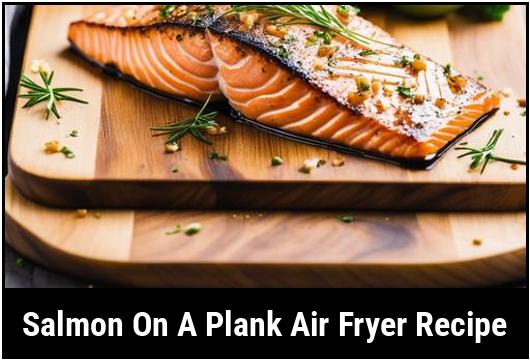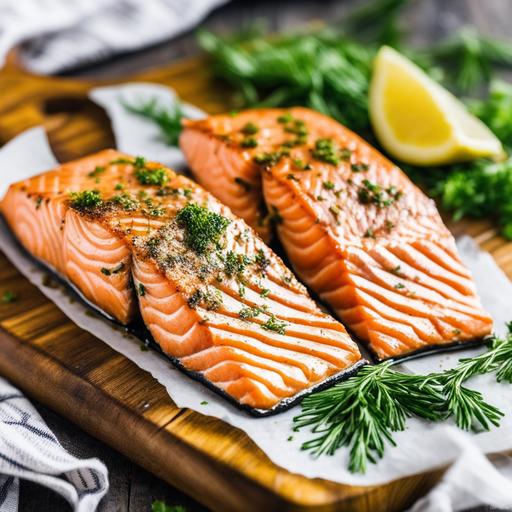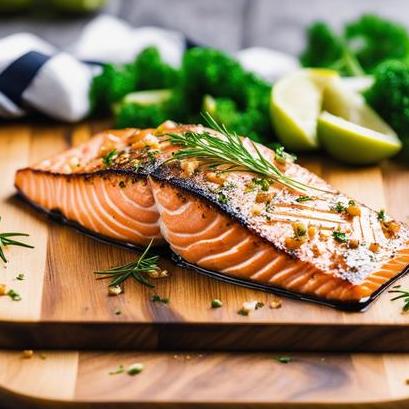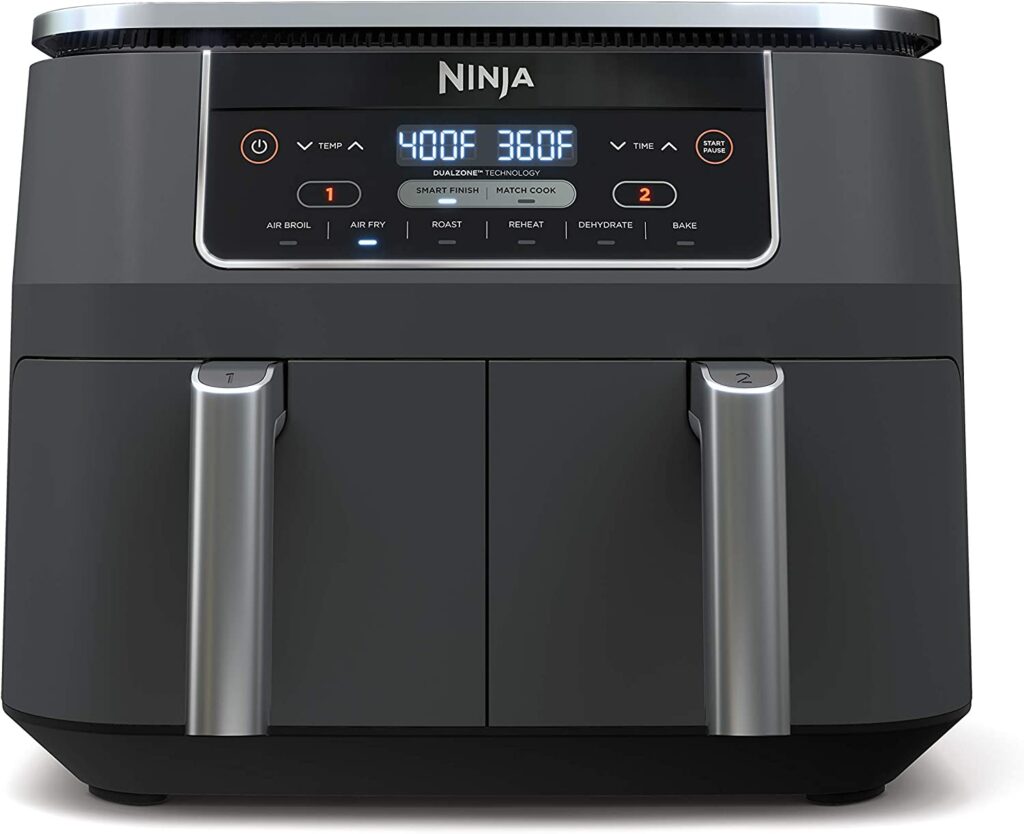The Ultimate Guide To Salmon On A Plank In An Air Fryer

Are you looking for a unique and delicious way to prepare salmon? Look no further! In this comprehensive guide, we will explore the fascinating world of cooking salmon on a plank using an air fryer. This innovative cooking method infuses the salmon with incredible flavors while maintaining its delicate texture. With the perfect blend of food science, culinary details, and practical tips, you’ll master the art of creating a mouthwatering salmon dish that will impress even the most discerning taste buds.
The Science Behind Salmon on a Plank
Cooking salmon on a plank in an air fryer is not just a trendy technique; it also has scientific benefits. The plank acts as a barrier between the heat source and the salmon, preventing direct heat transfer and resulting in a slower cooking process. This allows the salmon to cook evenly while retaining its natural moisture and tenderness.
When it comes to food science, the air fryer plays a crucial role. Unlike traditional frying methods that require a large amount of oil, the air fryer uses a powerful circulating hot air mechanism to cook your food. This means you can achieve a crispy exterior and moist interior without excess oil, resulting in a healthier dish.
Selecting the Perfect Plank
Choosing the right plank is essential to ensure the success of your salmon dish. Opt for planks made of cedar or alder wood, as they impart a delightful smoky flavor to the fish. Ensure that the plank is untreated and food-safe.
Cleaning the Plank

Before using the plank, it’s important to clean it thoroughly to remove any dirt or debris. Start by scrubbing the plank with a stiff brush to eliminate any residual sawdust. Avoid using soap as it can leave unwanted flavors on the plank. Instead, rinse it with hot water and pat dry.
Preparing the Plank

To enhance the flavors and prevent the plank from burning, pre-soak it in water for at least one hour before cooking. Soaking helps the wood absorb water, ensuring a slow and smoky cooking process.
Preparing the Salmon

Now that you have your plank ready, it’s time to focus on the star of the dish – the salmon. Begin by choosing the freshest salmon fillets available. Look for vibrant color, firm texture, and a mild oceanic aroma.
To prepare the salmon, carefully remove any pin bones using tweezers or pliers. Season both sides with your favorite blend of spices and herbs, such as dill, lemon zest, salt, and pepper. Let the flavors meld with the fish by allowing it to marinate for at least 30 minutes.
Tips for Success

Achieving the perfect salmon on a plank in an air fryer requires attention to detail. Here are some important tips to keep in mind:
-
Oil the plank: Before placing the seasoned salmon on the plank, lightly oil its surface to prevent sticking.
-
Preheat the air fryer: To ensure an even cooking process, preheat your air fryer to the desired temperature before placing the plank inside.
-
Arrange the plank strategically: Place the pre-soaked plank in the air fryer basket, ensuring it is centered and not touching the heating element. This will ensure consistent heat distribution.
-
Avoid overcrowding: To prevent the salmon from steaming instead of getting a crispy exterior, avoid overcrowding the air fryer basket. Cook the salmon in batches if necessary.
Variations and Flavor Enhancements
While cooking salmon on a plank in an air fryer delivers incredible flavor on its own, there are several variations and flavor enhancements you can explore:
1. Citrus Infusion
Introduce a burst of citrusy flavors by adding slices of lemon, lime, or orange on top of the seasoned salmon fillets before cooking. The natural acidity from the citrus fruits will complement the richness of the salmon.
2. Herbaceous Delight
Experiment with various herbs to elevate the flavor profile. Fresh dill, thyme, and rosemary are excellent choices. Place a few sprigs on the plank and let the aromas infuse into the salmon while cooking.
3. Spicy Kick
For those who enjoy a bit of heat, sprinkle some red pepper flakes or cayenne pepper on the salmon before placing it on the plank. This will add a pleasant kick to your dish.
Checking for Doneness
Cooking salmon to perfection requires careful attention to ensure it is cooked through yet remains moist and tender. Here are a few ways to check for doneness:
-
Internal Temperature: Use a meat thermometer to check the internal temperature of the thickest part of the salmon. It should read 145°F (63°C).
-
Flakiness: Gently insert a fork into the thickest part of the salmon and twist it slightly. If the fish flakes easily, it is likely done.
-
Color and Texture: Fully cooked salmon will have an opaque pink color and a slightly firm but still tender texture.
Recipe: Cedar Plank Air Fried Salmon
Now that you are equipped with all the necessary knowledge, it’s time to put it into practice by following this delicious recipe for cedar plank air fried salmon:
Ingredients:
- 2 fresh salmon fillets
- 1 cedar plank (pre-soaked for 1 hour)
- 2 tablespoons of olive oil
- 1 tablespoon of fresh dill (chopped)
- Zest of 1 lemon
- Salt and pepper to taste
Instructions:
- Preheat the air fryer to 375°F (190°C).
- Remove any pin bones from the salmon fillets using tweezers or pliers.
- In a small bowl, mix together the olive oil, fresh dill, lemon zest, salt, and pepper.
- Rub both sides of the salmon fillets with the mixture.
- Lightly oil the pre-soaked cedar plank to prevent sticking.
- Place the seasoned salmon fillets on the plank.
- Carefully place the plank in the preheated air fryer, ensuring it is centered and not touching the heating element.
- Cook for 12-15 minutes or until the salmon reaches an internal temperature of 145°F (63°C).
- Carefully remove the plank from the air fryer using oven mitts.
- Let the salmon rest for a few minutes before serving.
Conclusion
Salmon on a plank in an air fryer is an extraordinary culinary experience that combines science, technique, and flavor. Now that you have a comprehensive understanding of the process, you are ready to embark on your journey to create a remarkable salmon dish that will leave a lasting impression on your taste buds. Soak your plank, prepare your salmon, and let your air fryer work its magic for a delightful meal that keeps you coming back for more.
Sources
FAQS On Salmon On A Plank Air Fryer Recipe
What Is A Plank For Cooking Salmon?
A plank is a wooden or cedar board that is used for cooking food, specifically for grilling or oven-roasting salmon.
Can You Cook Salmon On A Plank In An Air Fryer?
Yes, you can! The method of using a plank to cook salmon can also be applied to an air fryer, resulting in a perfectly cooked and flavorful dish.
What Are The Benefits Of Using A Plank To Cook Salmon?
Using a plank adds a smoky and woody flavor to the salmon, while also keeping it moist and preventing it from sticking to the cooking surface.
How Do You Prepare A Plank For Cooking Salmon On An Air Fryer?
Soak the plank in water for at least an hour before using it to prevent it from catching fire in the air fryer. You can also add herbs, spices, or citrus slices to the water for additional flavor.
Do You Need To Preheat The Air Fryer Before Cooking Salmon On A Plank?
Yes, it is recommended to preheat the air fryer to the desired temperature before placing the salmon and plank inside. This ensures even cooking and prevents the salmon from drying out.
How Long Does It Take To Cook Salmon On A Plank In An Air Fryer?
The cooking time may vary depending on the thickness of the salmon and the temperature of the air fryer, but generally it takes about 12-15 minutes at 375°F.
Can You Reuse The Plank For Cooking Salmon In The Air Fryer?
Yes, you can reuse the plank a few times, but make sure to clean it thoroughly after each use. Soaking it in hot, soapy water and scrubbing off any remaining residue should do the trick.


